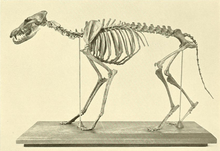Pleistocene coyote
| Pleistocene coyote | |
|---|---|
 | |
| Scientific classification | |
| Kingdom: | Animalia |
| Subkingdom: | Eumetazoa |
| Phylum: | Chordata |
| Subphylum: | Vertebrata |
| Class: | Mammalia |
| Order: | Carnivora |
| Family: | Canidae |
| Genus: | Canis |
| Species: | Canis latrans |
| Subspecies: | C. l. orcutti |
| Trinomial name | |
| Canis latrans orcutti Merriam, 1910 | |
The Pleistocene coyote (Canis latrans orcutti), also known as the Ice Age coyote, was a subspecies of coyote that lived in western North America during the Late Pleistocene. Most remains of the subspecies have been found in southern California, though at least one was discovered in Idaho. It was part of a carnivore guild that included other canids like foxes, gray wolves, and dire wolves.[1]
Compared to their modern Holocene counterparts, Pleistocene coyotes were larger and more robust, weighing 39–46 lb (18–21 kg),[2] likely in response to larger competitors and prey rather than Bergmann's rule.[1] Pleistocene coyotes were also likely more specialized carnivores than their descendents, as their teeth were more adapted to shearing meat, showing fewer grinding surfaces suited for processing vegetation. The lower jaw was also deeper, and the molars showed more signs of wear and breakage than modern populations, thus indicating that the animals consumed more bone than today.[3] Behaviourally, it is likely to have been more social than the modern coyote, as its remains are the third most common in the La Brea Tar Pits, after dire wolves and sabre-toothed cats, both thought to be gregarious species.[1]
Their reduction in size occurred within 1000 years of the Quaternary extinction event, when their large prey died out.[1] Furthermore, Pleistocene coyotes were unable to exploit the big game hunting niche left vacant after the extinction of the dire wolf, as it was rapidly filled by gray wolves, which likely actively killed off the large-bodied coyotes, with natural selection favouring the modern gracile morph.[3] Human predation on the Pleistocene coyote's dwindling prey base may have also impacted the animal's change in morphology.[1]
References
- 1 2 3 4 5 Meachen, J., Samuels, J. (2012). Evolution in coyotes (Canis latrans) in response to the megafaunal extinctions. PNAS : 10.1073/pnas.1113788109
- ↑ Choi, C. Q. (February 27, 2012). How Coyotes Dwindled to Their Modern Size. LiveScience
- 1 2 Meachen JA, Janowicz AC, Avery JE, Sadleir RW (2014) Ecological Changes in Coyotes (Canis latrans) in Response to the Ice Age Megafaunal Extinctions. PLoS ONE 9(12): e116041. doi:10.1371/journal.pone.0116041